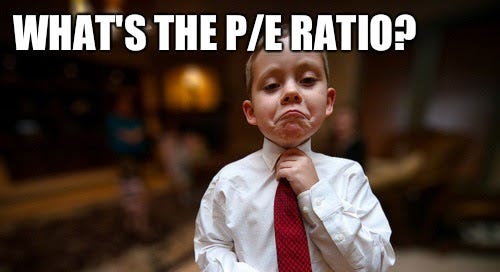What is PE Ratio & Earnings Yield- Everything you need to know about them
What are they and how to use them when analyzing a company
If you're new to investing, 'P/E' might sound more like 'physical education' than finance. But don't worry, it's not a gym class. The P/E ratio is a key concept every investor should learn.
The company's price-to-earnings ratio or the PE ratio (P/E ratio) is a financial metric used to express how much an investor earns for every dollar of earnings by the company.
P= is the market price of a share or investment security that is being traded at
E= Earnings per share that the company has earned over the last 12 months
A simple way to look at the P/E ratio is it provides information on how many years of a company’s current earnings it would require to equal to the current share price.
Coffee Shop Example to better understand P/E Ratio:
Let’s go through an example to make this concept clear. Imagine you and a friend starting a coffee shop called Great Coffee.
Let’s say your coffee shop is valued at $100,000, and you decide to create 1,000 shares. So each share is valued at $10 ($100,000/1,000). And if Great Coffee produces a steady $1 earnings per share annually. The PE ratio is 10x ($10/$1).
This means if you buy the stock of Great Coffee for $10 and it produces $1 earnings per share per year, you will get your investment back in 10 years.
What is the return on your investment now?
To find out, we divide the earnings per share by the price that you paid for one share. This is also called Earnings Yield, which is the inverse of the P/E ratio.
Earnings Yield provides investors with information on the annual return they can expect from a company based on its current stock price and earnings.
So your annual return on your capital when you invest in Great Coffee is 10%. 10% annual return on your capital is not a bad investment, if you are happy with that return you should but the stock in the company.
A simple way to think about the P/E ratio is, that the lower the P/E ratio is, the cheaper the company is to buy. the higher the P/E Ratio, the more expensive a company is to buy
The P/E ratio makes it easy for investors to compare opportunities to each other. For example, if the Great Coffee PE ratio is 10 and the P/E ratio of Starbucks is 20, then you could argue that Great Coffee Company is a more attractive investment than Starbucks (holding all else equal). That’s just because Great Coffee Company’s P/E ratio of 10 is much cheaper than Starbucks’ P/E ratio of 20.
You can also use the P/E ratio to compare to a group of stocks such as the S&P 500 Index. If the S&P 500 Index average P/E ratio is 25, then Great Coffee company is a better buy than the average company in the S&P 500.
Why don’t we just buy companies with lower PE ratios?
The P/E ratio is just one of many metrics investors use to evaluate a company's valuation. It provides insight into the return on investment based on the company's earnings. However, a high or low P/E ratio alone doesn’t determine whether a stock is a good or bad investment.
A high P/E ratio doesn’t necessarily mean a company is overpriced—it often reflects strong future growth expectations. Conversely, a low P/E ratio could indicate an undervalued stock or signal potential risks.
Let’s explore this concept with an example, demonstrating how a company with high growth potential can trade at a higher P/E ratio while still delivering strong long-term returns.
Investors often pay a premium (high P/E) for growth companies because they expect substantial earnings expansion over several years. Let’s take a deeper look at how high growth can justify a high P/E over a 3- to 5-year period.
Example: Company A (High-Growth Tech) vs. Company B (Great Coffee Company)
Both companies start with a $10 stock price but have different earnings growth rates.
Projecting Earnings Growth Over 5 Years
We calculate future EPS assuming consistent annual growth.
Company A (High-Growth Tech Firm, 35% EPS Growth per Year)
Company B (Mature Business, 5% EPS Growth per Year)
Impact on Stock Price Over 5 Years
For simplicity, let’s assume that both companies maintain their current P/E ratios (though in reality, a high-growth company’s P/E may compress as earnings grow).
Company A (Tech, High Growth)
Stock Price=1.12×40=$44.8
Stock price increases from $10 → $44.8 in 5 years (348% gain).
Company B (Mature, Slow Growth)
Stock Price=1.28×10=$12.8
Stock price increases from $100 → $128 in 5 years (28% gain).
High P/E companies can deliver massive returns if growth materializes.
Even though Company A looked “expensive” at 40 P/E, its rapid earnings growth resulted in substantial stock appreciation over 5 years.
Company B, despite its low P/E (10), struggled to generate meaningful returns due to slow earnings growth.
Investors should look beyond P/E in isolation and focus on earnings growth potential over multiple years.
This is why companies like Amazon (AMZN), Tesla (TSLA), and Nvidia (NVDA) had high P/E ratios for years but delivered exponential returns.
Real-World Example: Amazon (AMZN) – High P/E, High Growth, Massive Returns
One of the best examples of a company that traded at a high P/E ratio for years but still delivered extraordinary returns is Amazon (AMZN).
Amazon's High P/E and Growth Story (1997 - Present)
Amazon went public in 1997, and for most of its history, it has traded at a very high P/E ratio—often exceeding 100x earnings. Many investors considered it "overvalued" for years, yet those who understood its growth potential saw incredible returns.
Key Takeaways from Amazon’s High P/E Journey
Amazon maintained a high P/E for years (often 100+), but investors were paying for future earnings growth.
EPS grew exponentially as Amazon reinvested profits into logistics, AWS (Amazon Web Services), and Prime, eventually justifying its high P/E.
As earnings caught up with stock price, Amazon’s P/E ratio naturally compressed, but long-term investors saw 10,000%+ returns over 20 years.
Amazon's P/E Ratio Compression Over Time
In the early 2000s, Amazon's P/E was 100-150x due to low earnings but high reinvestment into growth.
By 2020, Amazon's earnings had scaled massively, bringing its P/E down to ~25x, even though the stock had multiplied in value.
This shows how a high P/E stock can still be a great investment if earnings growth materializes.
Conclusion:
A high P/E doesn’t always mean overvalued—it can reflect growth potential.
Companies reinvesting profits (like Amazon) may have low earnings today but explosive earnings later.
Looking at just P/E without considering future earnings growth can lead to missed opportunities.
PE ratio should be only used as one of the many metrics to value a company
In my future posts, I will go into the details of how to value a company and other important metrics to look into before making an investment decision.
Having a structured and consistent investing approach helps minimize downside risk when you're wrong while maximizing upside potential when you're right. By following this disciplined strategy, my portfolio has achieved a 40%+ CAGR since inception.
Disclaimer: This post is for educational purposes only and should not be considered financial advice. Always do your own research before making investment decisions.










